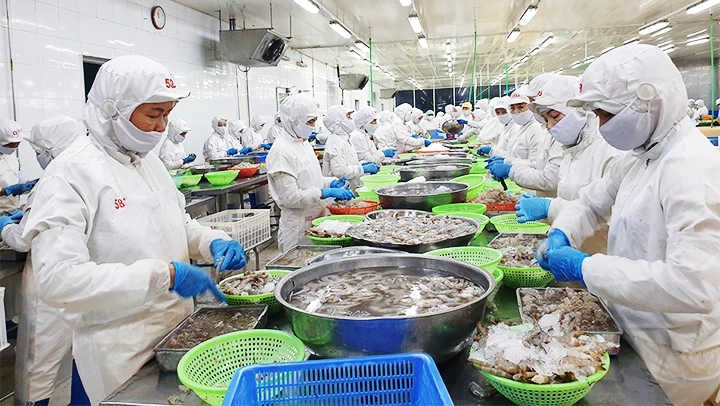Catching the recovery wave
In the first seven months of 2024, Vietnam's export turnover was estimated at 226.98 billion USD, up 15.7% year-on-year. Notably, exports grew strongly and evenly across all three main product groups. Leading the charge was the export turnover of the processed and manufactured goods sector, estimated at nearly 192 billion USD, accounting for 84.6% of total exports, and up 15.4% compared to 2023.
Additionally, the agricultural sector continued its growth trend from 2023. Total export turnover of this sector was estimated at 21.4 billion USD, up 19.6% year-on-year, accounting for 9.4% of the country's total export turnover. The export turnover of the mineral fuel group was estimated at 2.35 billion USD, up 0.6% compared to 2023.
Experts are optimistic about the resurgence in trade activities, noting that exports are experiencing a recovery wave after a lacklustre 2023. Director of Analysis at ACB Securities Company (ACBS) Tran Nhat Trung, believed that in the remaining months of 2024, Vietnam's exports will continue to grow compared to the low levels of 2023, as key export markets are actively stocking up for the year-end shopping season. Among the sectors, textiles, wood products, and seafood are expected to play significant roles in export-import activities in the coming period.
In the first seven months of this year, textile exports reached 19.8 billion USD, up 4.2% year-on-year. Wood and wood product exports amounted to nearly 8.9 billion USD, up 23.4%. Seafood exports reached 5.3 billion USD, up 7.3% year-on-year. PSI Securities also expressed confidence in the textile and seafood sectors, suggesting that the recovery in demand in the US market is a key driver for the textile industry to maintain and increase orders.
Moreover, political instability leading to disruptions in the textile production chain in Bangladesh, one of Vietnam's main competitors in the textile sector, could offer short-term advantages to Vietnam as brands focus on supplies for the upcoming winter season.
In the seafood industry, the export volume of tra fish is also expected to recover strongly in the second half of the year, thanks to reduced inventory levels in key markets, especially the US, compared to last year. Seafood companies can also leverage the low anti-dumping tax rate (POR 19) to enhance profit margins. Similarly, shrimp exports improved in the first half of the year and are expected to continue recovering in the second half. Notably, shrimp prices in the Japanese market may increase, as Vietnamese processed shrimp products remain popular and transportation costs are lower.
Proactive response to challenges
In addition to the potential for growth, experts caution that exchange rate fluctuations, reliance on imported raw materials, rising sea freight costs, global political instability, and the push for green products in developed countries are significant obstacles to the recovery of production and exports.
Vietnamese goods are still positioned within specific segments of the global value chain, making them vulnerable to disruptions in both supply and demand. Monetary policy and the economic conditions of export markets are major macroeconomic factors influencing the health of import-export businesses. Moreover, the recent surge in logistics costs has significantly impacted profit margins for these companies.
The challenge of green transformation is also becoming a significant hurdle for export businesses. With major import markets like the US and EU increasingly demanding green products and carbon-labeled goods, experts advise businesses to swiftly implement a "dual transformation"—digital and green transformation—if they want to remain in the value chain. Associate Professor Nguyen Huu Huan from the University of Economics Ho Chi Minh City (UEH) emphasised that green transformation is inevitable in the near future. While some sectors may not yet require carbon credits, most products exported to the EU and US will soon need to comply. Vietnam has committed to achieving net-zero emissions by 2050, but the transition plan to meet this goal remains unclear.
In the textile industry, Chairman of the Vietnam Textile and Apparel Association (Vitas) Vu Duc Giang, highlighted the need for businesses to focus on sustainable development criteria alongside product quality, pricing, and delivery times to reach the 2024 export target of 44 billion USD (up 9.2% from 2023). Major import markets like the US, the EU, and Japan place increasing demands on Environmental, Social, and Governance (ESG) indicators and LEED (Leadership in Energy and Environmental Design) standards. For example, garments exported to Europe must be made from cotton, or polyester blended with recycled fibres or surplus textile products.
To boost export-import activities in the remaining months of the year, Minister of Industry and Trade Nguyen Hong Dien stated that the ministry will strengthen coordination with other ministries, sectors, and localities to focus on consolidating traditional major markets, expanding new markets, and supporting businesses in meeting new green standards. This includes promoting trade, accessing potential markets, and investigating anti-dumping measures against Vietnamese goods. The Ministry of Industry and Trade will also closely monitor market developments and export-import policies of other countries to promptly inform associations and businesses.
In the first seven months of 2024, Vietnam had 30 export items exceeding 1 billion USD in turnover, accounting for 91.9% of total export turnover. Of these, nine items surpassed 5 billion USD in exports, accounting for 70.8%, including electronics, computers and components, phones and components, machinery and equipment, textiles, footwear, wood and wood products, transportation and spare parts, steel, and seafood.
















